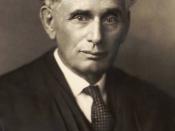Since the adoption of the First Amendment the Supreme Court of the United States has struggled to define what is obscene. In 1873 the Comstock Act was adopted in the wake of the civil war (Pember 439). The Comstock Act was criticized for being too strict, to the point where freedom of speech was being restricted. The Hicklin rule was an attempt to define what was considered obscene under the Comstock Act. Under the Hicklin rule a work was obscene if it had a tendency to deprave and corrupt those whose minds are open to such immoral influences and into whose hands it might fall (Pember 439). Clearly this rule was extremely broad and did little to define what obscenity actually was and, therefore, what was not protected under the First Amendment. Thus the controversy arises. Assuming that obscene material should be illegal, what is the definition of obscene?
The current test that the courts use to define what is obscene is the Miller test.
In the 1973 court case, Miller v. California, Marvin Miller was convicted of violating the California Penal Code for sending five unsolicited brochures to a restaurant in Newport Beach (Pember 440). The majority of the Supreme Court reached an agreement on the definition of obscenity that is still used today. The Miller test is comprised of three prongs.
Briefly, a material is considered obscene if these standards are met. The three elements of interest are:
I)An average person, applying contemporary local community standards, finds that the work, taken as a whole, appeals to prurient interest.
II)The work depicts in a patently offensive way sexual conduct specifically defined by applicable state law.
III)The work in question lacks serious literary, artistic, political or scientific value.
Simply reading these three elements of this law one realizes the...



Obscenity
Well-done, pretty in-depth. Could be a good research tool.
2 out of 2 people found this comment useful.